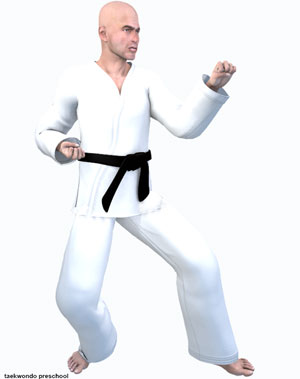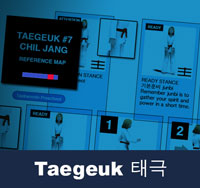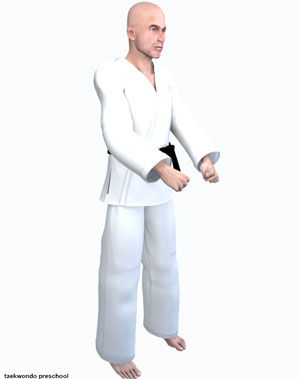Taekwondo 태권도Taekwondo Preschool
Promotion from one geup to the next can proceed rapidly in some schools, since schools often allow geup promotions every two, three, or four months. Students of geup rank learn the most basic techniques first, and then move on to more advanced techniques as they approach first dan. Many of the older and more traditional schools often take longer to allow students to test for higher ranks than newer, more contemporary schools, as they may not have the required testing intervals. View Taekwondo belt levels »
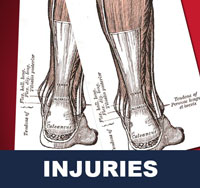
About Bone Fracture
Sports injuries are injuries that occur in athletic activities. They can result from acute trauma, or from overuse of a particular body part. Please see a certified specialist or doctor for sports injuries. Proper guidance and instructions are needed from a certified Master Instructor ( 사범님 sabeomnim ) to ensure safe training.

A bone fracture (sometimes abbreviated FRX or Fx, Fx, or #) is a medical condition in which there is a break in the continuity of the bone. A bone fracture can be the result of high force impact or stress, or a minimal trauma injury as a result of certain medical conditions that weaken the bones, such as osteoporosis, bone cancer, or osteogenesis imperfecta, where the fracture is then properly termed a pathologic fracture. Although broken bone and bone break are common colloquialisms for a bone fracture, break is not a formal orthopedic term.
Signs and Symptoms
Although bone tissue itself contains no nociceptors, bone fracture is painful for several reasons:
- Breaking in the continuity of the periosteum, with or without similar discontinuity in endosteum, as both contain multiple nociceptors.
- Edema of nearby soft tissues caused by bleeding of torn periosteal blood vessels evokes pressure pain.
- Muscle spasms trying to hold bone fragments in place
Damage to adjacent structures such as nerves or vessels, spinal cord and nerve roots (for spine fractures), or cranial contents (for skull fractures) can cause other specific signs and symptoms.
Pathophysiology
The natural process of healing a fracture starts when the injured bone and surrounding tissues bleed, forming a fracture hematoma. The blood coagulates to form a blood clot situated between the broken fragments. Within a few days blood vessels grow into the jelly-like matrix of the blood clot. The new blood vessels bring phagocytes to the area, which gradually remove the non-viable material. The blood vessels also bring fibroblasts in the walls of the vessels and these multiply and produce collagen fibres. In this way the blood clot is replaced by a matrix of collagen. Collagen's rubbery consistency allows bone fragments to move only a small amount unless severe or persistent force is applied.
At this stage, some of the fibroblasts begin to lay down bone matrix in the form of collagen monomers. These monomers spontaneously assemble to form the bone matrix, for which bone crystals (calcium hydroxyapatite) are deposited in amongst, in the form of insoluble crystals. This mineralization of the collagen matrix stiffens it and transforms it into bone. In fact, bone is a mineralized collagen matrix; if the mineral is dissolved out of bone, it becomes rubbery. Healing bone callus is on average sufficiently mineralized to show up on X-ray within 6 weeks in adults and less in children. This initial "woven" bone does not have the strong mechanical properties of mature bone. By a process of remodeling, the woven bone is replaced by mature "lamellar" bone. The whole process can take up to 18 months, but in adults the strength of the healing bone is usually 80% of normal by 3 months after the injury.
Several factors can help or hinder the bone healing process. For example, any form of nicotine hinders the process of bone healing, and adequate nutrition (including calcium intake) will help the bone healing process. Weight-bearing stress on bone, after the bone has healed sufficiently to bear the weight, also builds bone strength. Although there are theoretical concerns about NSAIDs slowing the rate of healing, there is not enough evidence to warrant withholding the use of this type analgesic in simple fractures.
Effects of Smoking
Smokers generally have lower bone density than non-smokers, so have a much higher risk of fractures. There is also evidence that smoking delays bone healing. Some research indicates, for example, that it delays tibial shaft fracture healing from a median healing time of 136 to a median healing time of 269 days. This means that the fracture healing time was approximately doubled in smokers. Although some other studies show less extreme effects, it is still shown that smoking delays fracture healing.
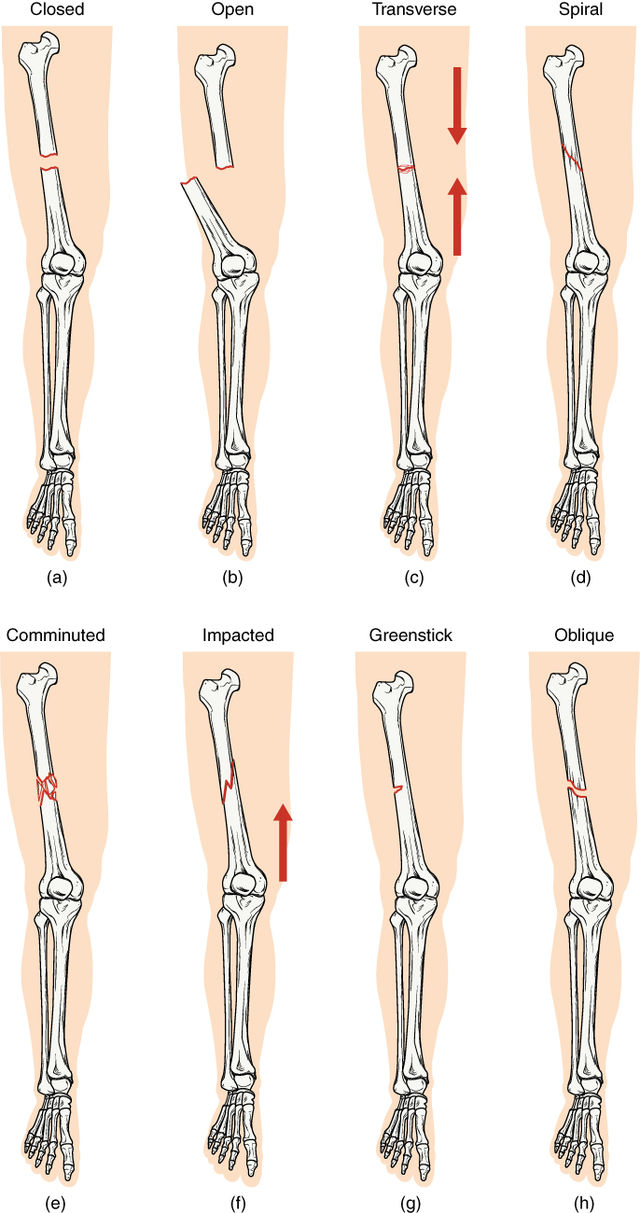
Orthopedic
In orthopedic medicine, fractures are classified in various ways. Historically they are named after the doctor who first described the fracture conditions. However, there are more systematic classifications in place currently.
All fractures can be broadly described as:
- Closed (simple) fractures: are those in which the skin is intact
- Open (compound) fractures: involve wounds that communicate with the fracture, or where fracture hematoma is exposed, and may thus expose bone to contamination. Open injuries carry a higher risk of infection.
Other considerations in fracture care are displacement (fracture gap) and angulation. If angulation or displacement is large, reduction (manipulation) of the bone may be required and, in adults, frequently requires surgical care. These injuries may take longer to heal than injuries without displacement or angulation.
- Compression fractures: usually occurs in the vertebrae, for example when the front portion of a vertebra in the spine collapses due to osteoporosis (a medical condition which causes bones to become brittle and susceptible to fracture, with or without trauma).
Other types of fracture are:
- Complete fracture: A fracture in which bone fragments separate completely.
- Incomplete fracture: A fracture in which the bone fragments are still partially joined. In such cases, there is a crack in the osseous tissue that does not completely traverse the width of the bone.
- Linear fracture: A fracture that is parallel to the bone's long axis.
- Transverse fracture: A fracture that is at a right angle to the bone's long axis.
- Oblique fracture: A fracture that is diagonal to a bone's long axis.
- Spiral fracture: A fracture where at least one part of the bone has been twisted.
- Comminuted fracture: A fracture in which the bone has broken into several pieces.
- Impacted fracture: A fracture caused when bone fragments are driven into each other.
- Avulsion fracture: A fracture where a fragment of bone is separated from the main mass.

Related Articles
Sports injuries are injuries that occur in athletic activities such as in taekwondo. They can result from acute trauma, or from overuse of a particular body part. Collisions with the ground, objects, and other practitioners are common, and unexpected dynamic forces on limbs and joints can cause injury. View Sport Injuries »
- Achilles Tendon - the Achilles tendon is the most commonly injured tendon. Rupture can occur while performing actions requiring explosive acceleration, such as pushing off or jumping.
- Bone Fracture - a bone fracture is a medical condition in which there is a break in the continuity of the bone. A bone fracture can be the result of high force impact or stress, or a minimal trauma injury as a result of certain medical conditions that weaken the bones, such as osteoporosis, bone cancer, or osteogenesis imperfecta.
- Pulled Hamstring - defined as an excessive stretch or tear of muscle fibers and related tissues. Hamstring injuries are common in athletes participating in many sports and are very difficult to treat and rehabilitate.
- Sprain - damage to one or more ligaments in a joint, often caused by trauma or the joint being taken beyond its functional range of motion. The severity of sprain ranges from a minor injury which resolves in a few days to a major rupture of one or more ligaments requiring surgical fixation and a period of immobilisation.
- Sprained Ankle - also known as an ankle sprain, twisted ankle, rolled ankle, floppy ankle, ankle injury or ankle ligament injury, is a common medical condition where one or more of the ligaments of the ankle is torn or partially torn.
- Strain - an injury to a muscle in which the muscle fibers tear as a result of overstretching. A strain is also colloquially known as a pulled muscle. The equivalent injury to a ligament is a sprain.
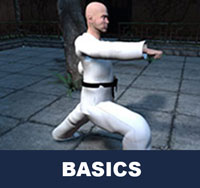
Taekwondo Basics
Here is where you can learn more about Taekwondo 태권도. Knowing the fundamental basics is very important for your learning path as you build your skills and knowledge. There are certain rules that need to be followed to show respect to the master ( 사범님 sabeomnim ), the instructors ( 교사님 gyosannim ), other practitioners and to the martial arts. They vary between schools but many have similar rules and guidelines. For more information View Taekwondo Basics »
Please see a certified specialist or doctor for sports injuries. The article provided on this page is information that is widely available on Wikipedia article "Bone Fracture". Risk of injury can be reduced by completing an effective warm up consisting of a heart raiser to get your pulse up, followed by sport specific dynamic stretches (stretches whilst moving). Please follow the guidance of a certified Master Instructor or trainer when doing sports related activities.
RESOURCES
This article uses material from the Wikipedia article "Bone Fracture", which is released under the Creative Commons Attribution-Share-Alike License 3.0.



